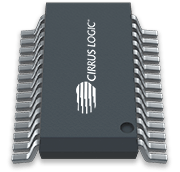

- Cirrus logic cs4398 vs texas instruments pcm5102 how to#
- Cirrus logic cs4398 vs texas instruments pcm5102 1080p#
Heck, on my portable DAC Amp that allows opamp chip rolling, simply swapping the bundled 5534 chips to a pair of AD797 made a very discernible difference to the signature in terms of bass and mid frequency output.Another 1080p quad-core Android phone, you say? Well, there's a bit more to it. So there is no direct comparison to say that an AKM AK4497SQ chip sounds 'mellower' than a ESS ES9038PRO chip unless the circuitry and endstage amplification designs and components are identical. Thus affecting the "signature" that is ultimately audible to our ears.Īnd of course, a lot of what we hear has more to do with the endstage output ( such as the opamps and related circuitry) than the digital front end too. And different rejection rates and different reconstruction methods as well as resampling / upsampling methods can alter the final waveform that's reproduced. If I understood his talk correctly, he was explaining that a lot the details we get to hear are a result of the final signal reproduction amidst the need for noise/ jitter rejection in the D to A process.

Chord's approach being different from either DS or R2R ladder.

Its not just a straightforward D to A conversion, as the algorithm and approaches used for different chips vary.

Interesting but if you were to ask Rob Watts, the guy who design most of Chord's stuff, as I attended one of his talks, I think he would say there are differences. Me, I'm good with the occasional ChiFi signal processor box, early 90's mid-fi gear, and lossless Redbook.Īll that said, I have never once heard someone walk into a listening room or clamp on some cans and say, "That is unquestionably an AKM DAC" without seeing the box first. If you are someone whose auditory system is one of those that is connected to your internal accounting system, buy some Dan D'Agostino monoblocks and Wilson speakers. If it does not sound right, or grates your nerves, try some other components. Don't get taken in by snake oil cable salesmen. Spend more on your speakers (or headphones). My advice? Build your system with components that test well and fit your budget. Lots of arguing and hand waving for not much, if any, result (and possibly hurt feelings). Even if we could do that, you still have to take the totality of the signal chain into account, and the measurements would have to be taken from the listening position, with all the issues that come with that. I wish I knew what metrics could even be used to define empirically all those glowing terms we love to toss about.
Cirrus logic cs4398 vs texas instruments pcm5102 how to#
Do they sound different? Sure, I guess, but the bigger question is how to quantify that when the graphs all look pretty much the same. If the spec is sufficient, and the implementation is good, it will produce an analog signal so purely that your ears will not be able to tell it from one by another maker that is equally good. I have listened to a lot of different DACs, and while I have found some to be more resolving than others or to have a house sound, component nervosa is kinda like chasing your tail. There are some out there that do it differently, I'm told, and that will affect the sound profile, perhaps. If you get an ESS DAC chip, there are a few other bits and bobs that come with it in order to make it work well, and rather than muck about with those, most companies just pop them right on the PCB in an approved configuration. I think that there is something to the Sabre (and AKM and Burr-Brown, etc.) sound, but that has more to with the 'approved implementation' hardware that often comes with them. I'm just as ill informed as the next guy, so as an American, I will not scruple to give you my opinion.


 0 kommentar(er)
0 kommentar(er)
